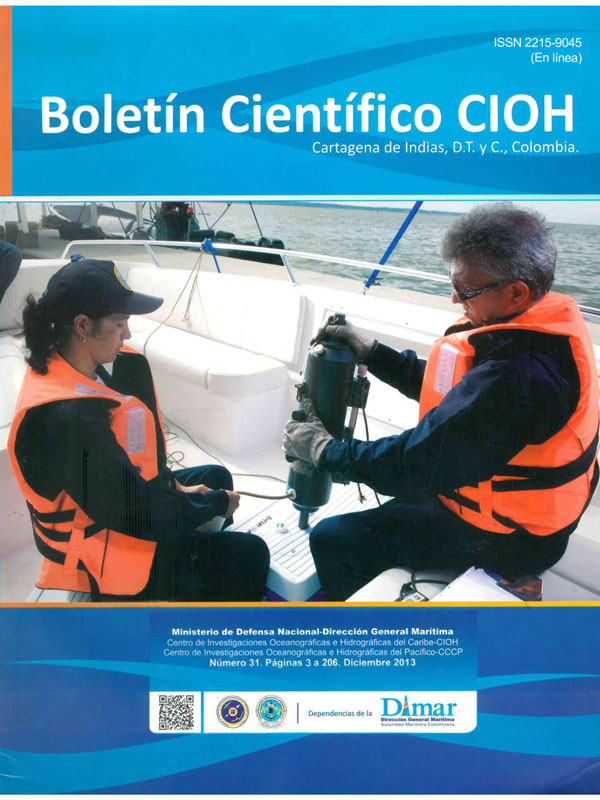Hydrodynamic characterization in a tropical estuarie of South America with mixed microtidal regime (Cartagena Bay Colombia)
DOI:
https://doi.org/10.26640/22159045.257Keywords:
tropical estuarine, residual circulation, wind-tide interaction, near shore currents, Caribbean Sea, Cartagena BayAbstract
Investigations about Hydrodynamic in tropical estuary with semidiurnal mixed micro tidal regime such as Cartagena's Bay in Colombia, until date hadn't shown a characterization of the current profile ant it's relation with the tidal regime and superficial winds. The present research identified that tidal regime had greater impact over the measurements points. The wind such as forcer agent mainly affected to the shallower measurement point and closer to the shore as well. The greater wind energy transference was identified over water mass in the 50 cm of distance up to surface. When winds flowed in the same direction as the tidal flow, the maximum currents velocities were located in the flood and ebb of the spring tides; when the wind direction was opposite to the currents direction, the maximum measurements were located in the neap tides as a delay of the hydrodynamic process. The maximum velocity in the medium profile of the in situ data was located 50 cm under surface in both observed point, showing the greater wind energy transference into the water column. The residual circulation was estimated, where southwards currents are predominant during dry season, and change to northward currents during wet and transition season.Downloads
References
[2] Lonin, S. 1993. Cálculo de la transparencia del agua en la Bahía de Cartagena. Bol. Cient. CIOH (18): 85-92.
[3] Lonin. S. y Giraldo. L. 1995. Circulación de las aguas y transporte de contaminantes en la bahía interna de Cartagena. Bol. Cient. CIOH (16): 25-56.
[4] Lonin. S. y Giraldo. L. 199. influencia de los efectos térmicos en la circulación de la bahía interna de Cartagena. Bol. Cient. CIOH (17): 47-56.
[5] CIOH 2004. Presencia de organismos exógenos y patógenos en aguas de las aguas de lastre de buques tráfico internacional (Fase III). Informe final. Grupo de investigacón Área de Protección del Medio Ambiente Marino-Grupo de Aguas de Lastre.
[6] De lisa, A. 2003. Estudio de la dinámica del caño El Zapatero. Trabajo de grado. Escuela Naval de Cadetes "Almirante Padilla" (ENAP). Cartagena, Colombia.
[7] Murillo, N. 2008. Caracterización en época seca de las variables oceanográficas por
la incidencia del Canal del Dique en la Bahía de Cartagena. Tesis. Escuela Naval de Cadetes "Almirante Padilla".
[8] Rueda-Bayona, J.G., Sánchez-Vargas. C.A. 2009. Estudio hidrodinámico de la Bahía de Cartagena mediante la aplicación de un modelo numérico bidimensional. Tesis. Escuela Naval de Suboficiales "ARC Barranquilla".
[9] CIOH. CIOH. [Online]. Cartagena de Indias; 2009 [cited 2010 02 7. Available www.cioh.org.co.
[10] CIOH. 2010. Régimen de vientos y corrientes Bahía de Cartagena. www.cioh. org.co.
[11] Arias. F. y Durán, E. 1984. Variación anual del fitoplancton en la Bahía de Cartagena. Boletín CIOH (5) 61-116.
[12] Martins, F., Leitao, P., CSilva, A. & Neves, R. 2001. 3D modelling in the Sado stuary using a new generic vertical discretization approach. Oceanologica Acta 24 (1) 551- 562.
[13] Vaz, N., Díaz, J.M., Leitao, P.C. & Nolasco, R. 2007. Application of the MOHID-2D model to a mesotidal temperate coastal lagoon. Computers & Geosciences (28) 1204-1209.
[14] Taboada, J.J., Prego, R., Ruiz-Villareal, M., Gómez-Gesteira, M., Montero, P., Santos, A.P. & Peréz- Villara, V. 1998. Estaurine, Coastal and Shelf Science (47): 661–670.
[15] Andersen, O.B., Woodworth, P.L. & Flather, R.A. 1995. Intercomparison of recent ocean tide models. J. Geophys. Res. (100): 25261-25282.
[16] Pedlosky, J. 1987. Geophysical Fluid Dinamics. s: Springer-Verlang. New York.
Downloads
Published
Issue
Section
License
Attribution — You must give appropriate credit, provide a link to the license, and indicate if changes were made. You may do so in any reasonable manner, but not in any way that suggests the licensor endorses you or your use.
NonCommercial — You may not use the material for commercial purposes.
NoDerivatives — If you remix, transform, or build upon the material, you may not distribute the modified material.
No additional restrictions — You may not apply legal terms or technological measures that legally restrict others from doing anything the license permits.



